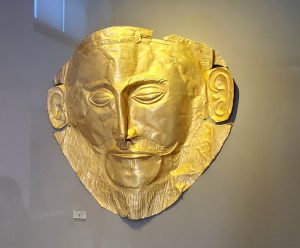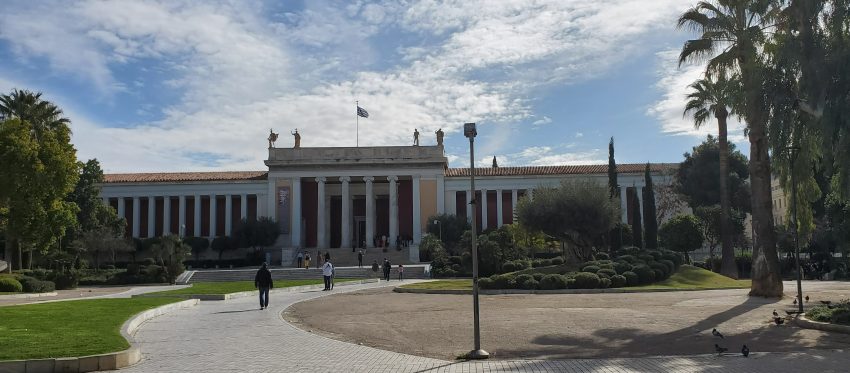I am always excited for a visit to Greece. Understanding the influence Ancient Greece has had on mathematics, philosophy, science, and democracy helps to understand more about modern society. And I love their food, culture, history and art so its all a plus.
On our most recent trip to Athens we were finally able to visit the National Archaeological Museum (https://www.namuseum.gr/en/). The space offers so much in the way of pottery and sculpture and helps the visitor to better understand their history. Even though I would love to discuss it all, we have chosen our top 5 works of historical art as a way to showcase the country.

- The Mask of Agamemnon
Legend states that Agamemnon was the leader of the Greeks during the Trojan War. He is said to have sacrificed one of his daughters to the goddess Artemis to make the wind blow so his ships could sail to Troy. This gold funeral mask was found in 1876 in Mycenae by amateur archeologist Heinrich Schliemann and thought to be the mask of the legendary King Agamemnon. Modern research however dates the mask from a much earlier era even though the name has stuck.

- Artemision Jockey
This exquisite bronze sculpture of a young boy atop a galloping steed is sure to capture your heart. The intense concentration on the face of the boy, who would have held the reins in his left hand and a whip in his right, and the fine musculature of the horse is stunning. Retreived in pieces from a shipwreck off the Cape of Artemision and reassembled in 1971 this piece dates from about 150 – 140 BC. It is rare to have bronze from Ancient Greece as most of it was melted down.

- Artemision Bronze
This was another bronze statute that was found between 1926 to 1928 in two pieces in a shipwreck near Cape Artemision. It dates to around 460 BC. Believed by most to be Zeus, he has his arm drawn to hurl a bolt of lightening. Other scholars feel it could also be Poseidon, the brother of Zeus, ready to throw his trident. It is well know for its depiction of motion and anatomy.

- Poseidon of Milos
This marble statute was found in 1877 and believed to date back to the Hellenistic period of Ancient Greece circa 125 – 100 BC. It was discovered on Milos and depicts the God with his arm raised most likely clutching his trident with a dolphin at his feet.

- Kourus
The Kouros was a common depiction of a nude male standing stiff with arms at his side and one leg slightly forward. It does not represent any one person but rather the idea of youth. This one, dating from about 530 BC, was stolen and taken to France before being returned in 1937. These statues were most commonly used as grave monuments. Females depicted in the same way were known as Kore.
Although there is so much to learn about Greece, be sure to include a visit to the beautiful islands and other modern cities that make up this sought after destination. There is ancient art in every museum as well as in many of the archaeological sites scattered throughout the country.
